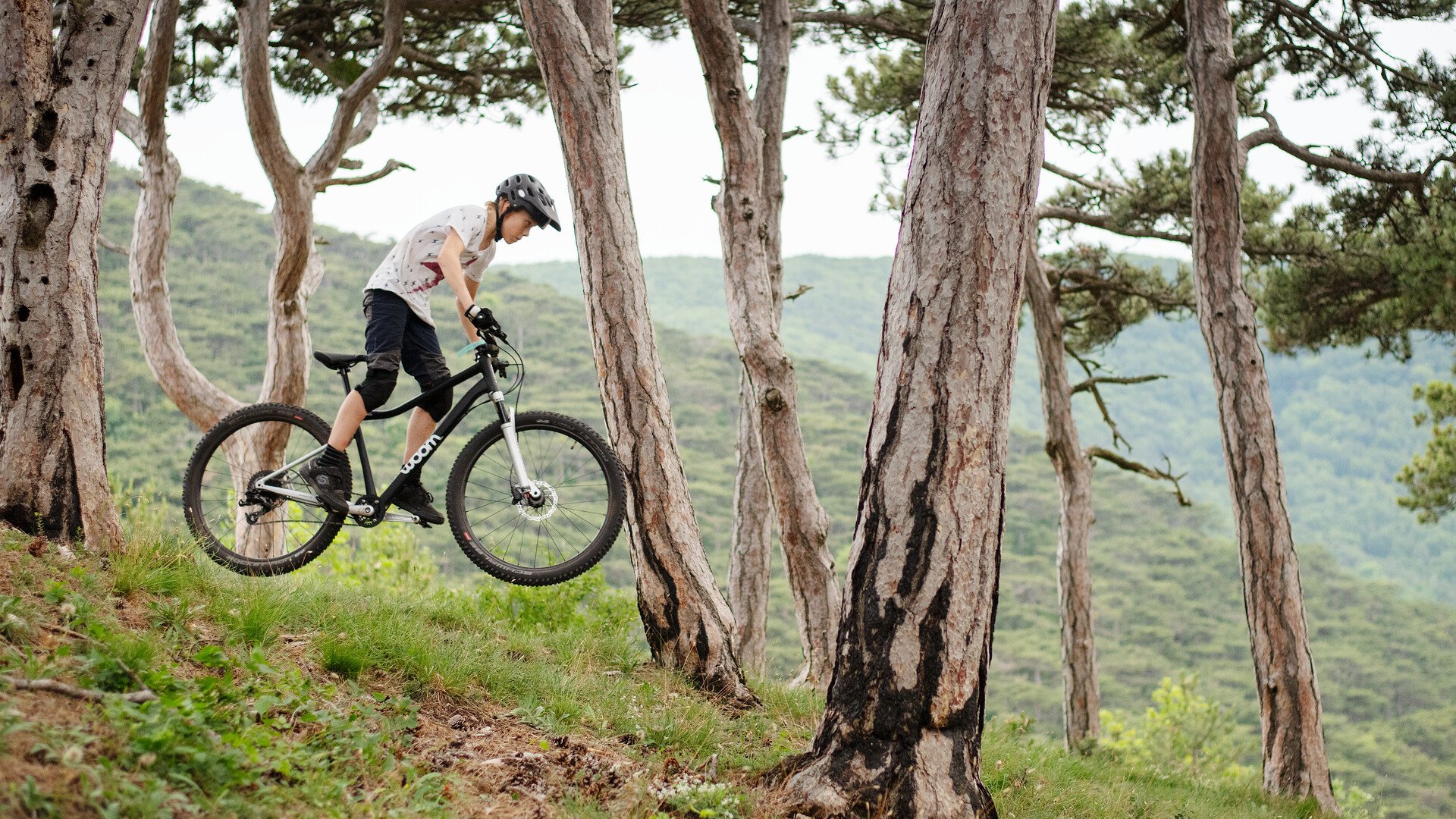A question of set-up: bike tweaks for your child to get max enjoyment on their MTB
The shiny, new mountain bike is box-fresh and newly assembled. Your child can barely wait to jump on it and get pedalling. We totally get it! But a poor set-up with a saddle that's too high, unreachable brake levers or tyres that are too hard will limit the fun on any bike – and that includes the world's coolest MTB.


That's why it's so important to set up the mountain bike so that each component is perfectly tuned to your child – particularly before the first ride or after an extended period away from the bike. After a growth spurt is another prime time to check on their bike fit, even if it's mid-season. The reason why? A rider can only enjoy full control and a confidence-inspiring ride if the bike is perfectly tuned to them.
In this bike fitting guide, we highlight the most important components and tell you which nuts and bolts will need twisting. Let's begin by looking at the bars:
Adjusting the reach of the brake levers
Got a good grip? Positioning the brake levers correctly is important so that your child can brake safely without undue effort and come to a stop in every situation. Your child's safety is the biggest priority here. Make sure they can comfortably reach the brake lever with their fingers without having to lift their hands off the bars.
Tip: A decent mountain bike will be equipped with high-quality disc brakes, like those found on our woom OFF. Disc brakes are a huge asset on kids' mountain bikes as they are easy to modulate and deliver a great braking performance without the need for a lot of force – one or two fingers will do the job.
The reach of the brakes – how far the lever is positioned away from the grips – can be easily adjusted by turning the adjustment screw on the brake levers.
- The more you screw it in, the closer the levers come to the handlebars;
- loosen the screw, and the distance increases.
Ideal scenario: You want the levers to be virtually parallel to the bars at the moment that the brakes start to bite. The brake lever should never touch the handlebar grip, even when squeezed hard.
You can also adjust the angle of the levers. This involves loosening the clamp bolt (but don't unscrew it fully). What you’re aiming for here is a straight line down your child’s forearms, wrist and fingers when on the brakes, so make sure there's no kink in their wrist. This retains a natural position for their wrist and will mean their hands won’t go to sleep while riding.
Positioning the gear shifter
Your child should be able to reach the gear shifter comfortably without having to strain their thumb. If they are unable to do this, loosen the screw of the shifter clamp and move the lever along the bars until it is optimally placed. Don't forget to re-tighten it in place!
Setting up the bars and stem
TThe bars are an important point of contact between bike and child. The bars aren't just partially supporting your child's body weight, they're also in charge of steering the front wheel. The shape of the bars and their position have an influence on your child's body position while riding, as well as how the ride feels and handles.
In recent years trends have leaned towards wide bars with a short stem. On technical terrain this set-up lends more stability and control. But before we reveal the ideal set-up for kids' mountain bikes, here's a basic whats-what of MTB bars:
- Riser: A sweeping form with the bar ends that are higher than the stem. This means your kid's hands are also higher, leading to a more upright riding position. You get great control and more comfort on steep sections.
- Flat bars: The opposite of riser bars. The linear design keeps the front end low to the ground, which ensures very good grip on flat trails.
- Backsweep: By sweeping the bars back towards the rider, the distance between the saddle and the bars is reduced so your child has a shorter reach. This results in a more relaxed and ergonomic position.
So, what's the correct position (angle and height) for your child's bars and saddle, and how to find it?
You should aim for a very slight bend in your child's arms as they hold the handlebars. Aim for an angle of roughly 45 degrees for their upper body, and have their upper arms at 90 to 100 degrees from the body.
The stem is the key piece when it comes to adjusting the height of the bars. Most stems can be fitted in two ways: negatively (with a downward slant) or positively. Both of our mountain bikes – the woom OFF and the woom OFF AIR – are built with this flip-flop system, allowing you to further tune the bike set-up to suit your child.
You can also adjust the angle of the bars by altering the stem. To do so, loosen the clamp bolt a little (not fully) and rotate the bars a few degrees within the stem. As with the brake levers, the correct position will look like a straight line from the forearm to the fingers. To achieve the optimal position on the bike, there's another key contact point between bike and rider that we need to look at:
Setting up the saddle height and position
A comfortable riding position is crucial for a good time on the bike – in terms of performance, pleasure and safety. Here's how to find the right height:
- Going low: When sat on the saddle, your child can place their feet/toes on the ground with ease, without any need for them to shift their weight excessively. In this position, your child is able to quickly make ground contact if something unexpected happens. It'll give them more confidence and therefore represents the best choice for brand-new riders.
- Going high: For kids with more experience, you can set the saddle in a more advanced position, especially for flat sections and climbs. Hold onto the bike firmly while your child sits on the saddle. Ask them to put their feet on the pedals, with the ball of their feet over the centre. Now position the saddle at such a height that the leg on the lowest pedal has a very slight bend in it. This will protect the knee from excessive strain while still enabling your child to put power into the pedals.
Tip: Lower their saddle (dropper post-style) before starting a technical descent. On long downhills, your child will adopt a different position – namely, stood up with their weight over the back wheel. The lower the saddle is at this point, the more room they have to move their body and keep the bike stable.
Is your child still not sitting comfortably?
It could be worth trying out these adjustments:
- The fore-aft position: The saddle is on rails and can be moved forwards and backwards in relation to the bars to adjust the distance to the handlebars. With a bigger distance between the bars and saddle, your child's riding position is more stretched-out and aero. This position is great for long rides and climbing. Note: if the saddle is too far back, their power transfer onto the pedals will suffer. You don't want the saddle to be so far forward that it adds stress to the knees.
To find the optimal setting, position the saddle with the pedals parallel to the ground, and use a plumb line to check that the kneecap is aligned with the centre of the axle on the pedal that is furthest forward. - Saddle tilt: The saddle should be positioned as evenly as possibly to avoid any imbalances in pressure. Encourage your child to give feedback as to what feels best, so try out different tilts if needed.
Please do not forget to re-tighten all screws after any tweaks!
The optimal tyre pressure for your child
OThe benefit of MTB tyres is that they can be ridden with lower air pressure, which means they don't just absorb bumps better but also provide better grip, resulting in more safety, especially when cornering.
The minimum and maximum air pressure is shown on the sidewalls of the tyres. Please note that there is no universally correct tyre pressure as it depends on the rider's weight and the type of cycling. For optimal grip and shock absorption, we recommend that the tyre compresses by around 15% when your child sits on the bike.
How do you decide the right pressure for your bike ride?
Pump them up pretty hard to begin, then ask your child to do a little test ride, including corners and some rough ground. After each lap, lower the tyre pressure by a small amount in both tyres. Ask your child to pay attention to how the bike grips, corners and behaves over bumps – and how it varies from lap to lap. With too little tyre pressure, the tyres are likely to wallow when cornering and feel unstable at high speeds. As soon as they can feel terrain (i.e. rocks) hitting the rims, this is a clear sign of too little pressure.
After tweaks and tune-ups like this, your child will be in a great position to get more out of their bike. Now, they're ready to shred!



